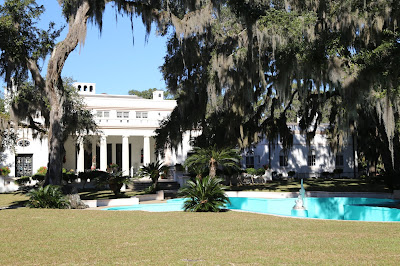Wednesday, December 4, 2019
Today was all about Sapelo Island.(pr:SAP-uh-low) Until I started planning this trip, I had never ever heard of it. That alone made it worth the trip. There's only one way to get there, by ferry. The state runs the ferry, as well as daily tours. Well worth the $15. Here's the rub, unlike Cumberland where they just drop you off, you either have to be a part of the official tour, or have a local resident sponsor your visit. You can't just show up.
But first, sunrise from behind the Inn..
After signing in with the visitor center and getting my ticket for the day, it was off to the ferry for the short ride to Sapelo Island. Other than private boats, it's the only way to get over to the island. For things like cars and anything too big for the ferry, there's a company that will bring things on their barge.
While reading up on this area, I came across references to San Miguel de Gualdape, a Spanish colony seemingly lost in time. In 1521, Lucas Vasquez de Ayllon, a wealthy sugar planter in Hispaniola, sent ships north to the Bahamas to bring back slaves. Having no luck, they followed a rumor of new lands to the north-west. They landed north of present day Charleston, SC, captured and brought back sixty indians to be slaves.
After hearing the stories from the ship's crews and the indians themselves, Ayllon traveled to Spain to seek permission to settle this new land and search for riches. The king set a few conditions. Ayllon was to explore and map the new land in depth, set up missions and convert the local population.
With a fleet of six ships, Ayllon sailed north mid-summer, 1526. Once again they landed north of Charleston. One ship and all it's cargo was lost after striking a sandbar. The soil turned out to be poor and the indian population too scattered for trade. They decided to relocate south.
No one has ever found any remnants of the new colony, but every article I read leans towards the mainland opposite Sapelo Island, the island itself or a few miles north. The new colony didn't last more than a few months. Disease, tainted water and lack of food took their toll. By November, the weather had turned cold. The local tribes had refused to help the colonists. So, they packed up, abandoned the colony and went back to Hispanola.
At the ferry terminal, we all met Evelyn, our tour guide. She's been living on the island for thirty-seven years. She met her future husband in high school. He lived on the island and took the ferry to a bus every morning. When they got married, she moved out here and never regretted it.
Most of the island is owned by the state. There's a large research complex for the University of Georgia and a wildlife sanctuary. Only a small portion is privately owned. It's in a community named Hog Hammock. After emancipation, the newly freed slaves created multiple communities around the island. Hog Hammock is the only one left, and some of the residents are descendants of the original families. It was named after Samson Hog, the caretaker of his previous owner's hogs.
But, that's slowly changing. There are very few jobs here. The kids grow up and leave to find work. Evelyn's kids live on the mainland. I asked where she gets groceries. Her kids buy them, put them on the ferry and she picks them up.
Property taxes are also hitting the community hard. Little by little, the housing lots are being sold off. More and more often, the new owners knock down the existing home and rebuilt a bigger one. This is causing property values to climb, as well as property taxes. The community has now shrunk to about thirty full time residents.
Since some of out are wondering about the lack of pictures, the first half of the tour was from the shuttle bus. The first time we all climbed out was for the Reynolds Mansion on the south end of the island. The first mansion was built here in the early 1800's by Thomas Spalding for his corn, cotton and sugar cane plantation. Every new owner renovated the mansion, the last being RJ Reynolds, jr in 1934. The Reynolds Mansion is now a hotel and event center. This time of year, they decorate and offer Christmas Tours, just not on Wednesdays.
On the southern tip of the island is where you'll find the lighthouse.
It was built here in 1820 and served the island until it was badly damaged in a hurricane in 1898 and replaced by a steel tower. By the 1930's, even the steel tower was removed. The original lighthouse remained dark until the late 1990's when it was restored and relit.
The door at the bottom of the tower is unlocked. However, you will need the key to the hatch to get up top. Being on the tour, we had access.
With about a half hour until we needed to be back at the ferry terminal, Evelyn drove us out to the beach on the east side of the island.
A few of us got to talking on the ferry ride back. We knew we were limited to the ferry the schedule and thus, only had a little over three hours. And while we enjoyed the tour, we all would have liked it to be a little longer.























No comments:
Post a Comment